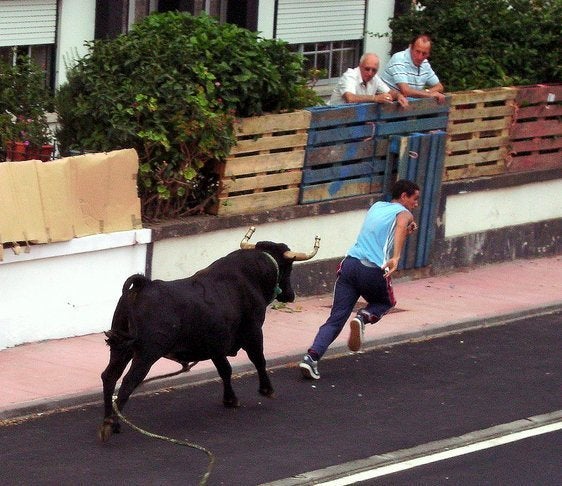
"I have been hit. It is not a good experience." These words come from Rui Costa, who is referring to being hit by a bull, a not uncommon occurrence on Terceira, the third largest of the nine Azores Islands sitting eight hundred miles off the coast of Portugal. Rui leans back in his chair and explains, "I was born into this. I have no choice, I love the bulls." It's a sentiment I hear often on Terceira.
There is talk of the bulls in every café I enter and TVs in shops play loops of ugly looking mishaps all day long. Between May and October, there are more than two-hundred-and-fifty touradas a corda on Terceira--the natives can't get enough.
The Azorian version of bull fighting bares little resemblance to the more famous Spanish tradition--for one thing, the bull does not die. There's no pageantry or formal code of conduct. There isn't a matador in fancy dress-up. The fights are usually held in town squares and on village streets.
It's not really a fight at all.
In essence, a bull is let loose, held somewhat in check by foolhardy men grasping at the end of a long rope. The beast charges at anyone foolish enough to run past and taunt him. As it turns out, many are.

Someone once said, "To understand America, you need to understand baseball." The same might be said for this island of fifteen-thousand and the bulls. So, late one afternoon, I make my way along the coast road to the outskirts of Sao Sabastiao, a postcard-ready, working class village, just above the ocean. A nice crowd gathers around a crossroads that forms a natural, if primitive, amphitheater. The tarmac is bordered by stone walls, except at either end, where traffic can move through. The entire village is here: They are two and three deep behind the walls and makeshift barricades. A hundred or so participants, mostly men, loiter in the street, where the bull will be let loose. Mist is rolling in off the sea and up over the hillside so the air is moist and fragrant. A sky-rocket goes up, the brown crate at the far end of the square is opened and a large, unhappy bull is let loose.
The men who had been loitering in the street are suddenly alert, and ease back to the far ends of the square, form where they can escape up the road if need arises. A half-dozen young men step forward and begin to take turns racing past the bull at close quarters, some play matador with open umbrellas. There is no order, no structure. The bull occasionally gets it into its head to charge the large group of men who have begun to creep closer. The men turn and flee like mice, while the gents in black hats holding the long rope around the bull's neck give it a good yank, bringing the animal back to the center of the intersection. This goes on for twenty minutes before the bull is reeled in and repacked in his crate.

Then the crowd chats and mingles. This is cocktail hour, Terceira style. Old men gather in twos and threes, leaning on umbrellas. Women congregate around open windows and young boys try to peek inside the crates that restrain the bulls. The few daring men who were in close quarters with the first bull accept the affections of young ladies. It's all very social, very work-a-day.
Another sky-rocket goes up and everyone scampers back to their spots. The next bull is loose.
Without thought, I hop down and join the group of men at one end of the coral. It all seems harmless enough, and it feels good to be in the midst of the crowd -- a temporary member of the community, however anonymous. The same six hardy souls taunt the bull and I puff up my chest with the others watching from a safe distance. Then the bull stops and turns his attention in our direction. taunt the bull and I puff up my chest with the others watching from a safe distance. Then the bull stops. He turns his attention in our direction. Now he's charging. Fast. Where did everyone go? Somehow, and suddenly, for an instant, there is no one between the bull and me.
I had no idea how fast I could run.